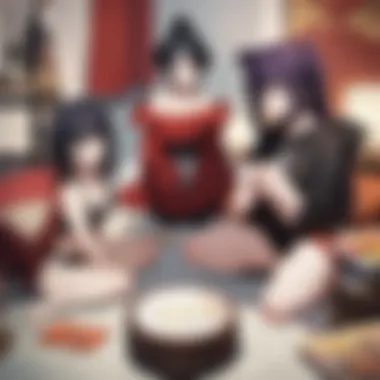The Comprehensive Guide to Watching Naruto


Intro
The Naruto series stands as a monumental achievement in the anime landscape. Emerging from Masashi Kishimoto's pen, this narrative extends well beyond simple entertainment. It embodies themes of friendship, perseverance, and self-discovery while weaving intricate character arcs. This guide aims to provide depth, connecting viewers to not just the storyline but also to the cultural elements that enrich the experience. Whether a newcomer or a veteran viewer, understanding the layers within Naruto enhances appreciation.
Episode Reviews
Summary of the Episode
Each episode in the Naruto series builds upon the overarching narrative, introducing viewers to the characters’ struggles, aspirations, and growth. For example, the early episodes focus on Naruto's quest for recognition and acceptance from his peers in the Hidden Leaf Village. Such foundational episodes lay the groundwork for character development and thematic evolution.
Analysis of Key Events
Key events serve as catalysts for change within the series. Throughout Naruto, pivotal moments like the fight against Sasuke and the appearance of powerful antagonists drive character dynamics. These events shape the narrative trajectory and influence relationships, showcasing how conflict propels growth.
Discussion on Character Development
Character development is a focal point in Naruto. Each fighter, from Naruto to Sakura, experiences significant transformations. Over time, Naruto transitions from a misunderstood outcast to a strong and confident leader. This evolution resonates deeply with audiences, reflecting real-life struggles.
Highlight Memorable Moments
Memorable moments punctuate the series, leaving lasting impressions.
- Naruto’s emotional speeches often inspire hope.
- Dramatic battles, like the clash between Naruto and Pain, deliver breathtaking animation and emotional depth.
- The final showdown between Naruto and Sasuke intertwines themes of rivalry and friendship.
These instances provide not only excitement but also substance, making them integral to the Naruto experience.
Character Spotlights
Background Information on the Character
Each main character carries unique backgrounds that inform their motivations. For instance, Sasuke Uchiha's tragic past fuels his desire for revenge, adding layers to his complex personality.
Personality Traits and Unique Quirks
Characters are shaped by their traits. Naruto's unwavering optimism contrasts sharply with Sasuke’s brooding demeanor. With quirks such as Naruto's love for ramen and Sasuke’s cool reserve, these distinctions create engaging dynamics.
Role in the Storyline
Every character contributes significantly to Naruto’s story. Naruto symbolizes growth and resilience, while Sasuke explores themes of vengeance and redemption. Their intertwined journeys captivate viewers, presenting varied perspectives on friendship and ambition.
Fan Theories and Speculations
The expansive world of Naruto invites ample fan speculation. Theories often sprout regarding character fates and hidden powers, driving community discussions on platforms like reddit.com. Such engagement fosters a rich cultural dialogue surrounding the series.
Anime vs. Manga Comparison
Plot Differences Between the Anime and Manga
While both the anime and manga tell the story of Naruto, they diverge in several instances. The manga presents a more concise storyline, often omitting filler episodes found in the anime adaptation. Fans sometimes prefer the pacing of the manga for its clarity.
Art and Animation Quality
Art style varies between the two forms. The manga’s simplicity contrasts with the anime’s dynamic visuals. The animation quality varies, particularly across different arcs, reflecting the production values and artistic choices made by studios.
Character Portrayal
In the anime, some characters receive expanded arcs, offering additional background not present in the manga. This allows for more emotional investment and a deeper understanding of character motivations.
Fan Preferences and Opinions
Fan opinions often lean towards the manga for its original storytelling but appreciate the anime's visual flair. Discussions about personal preferences can be found in various online forums, highlighting the divided opinions among enthusiasts.
Industry News and Updates
Announcements on Upcoming Releases
As a continually evolving franchise, Naruto has seen announcements related to spin-offs and adaptations. Series such as "Boruto: Naruto Next Generations" fulfill the desire for more storytelling within this universe.
Analysis of Industry Trends
The success of Naruto has influenced industry trends, with similar series emerging that emphasize character-driven plots and rich world-building. Such trends can shift viewer expectations for new anime productions.
Insight into the Production Process
Behind the scenes, the production of Naruto involved skilled animators and voice actors who enriched the characters' personalities. The collaboration among various departments underscored the complexity of bringing the series to life.
Top Lists
Ranking of Favorite Characters or Episodes


Fans enjoy compiling lists of their favorite episodes or characters. The strong connection viewers have with characters such as Kakashi and Gaara often reflects personal stories and experiences.
Compilation of Best Fight Scenes
Notable fight scenes such as Naruto vs. Sasuke at the Valley of the End rank high for their emotional stakes and beautifully choreographed animation.
Comparison of Different Genres Within Anime and Manga
This series exemplifies a rich blend of genres, from action to drama. Such versatility appeals to a diverse audience, making it a significant part of anime culture.
Audience Polls and Feedback
Audience engagement through polls can highlight preferences on various platforms, shaping subsequent discussions within the community. This interaction strengthens the bond fans share for the series.
With these elements in play, one can appreciate the depths of Naruto, its intricate storytelling, and the cultural significance it has in the world of anime.
Preamble to Naruto
The introduction to Naruto is critical in understanding the broader context of the series. This section sets the stage for exploring not only the plot but also the underlying themes and character dynamics that resonate throughout this iconic anime. By examining the background and the creators behind the series, readers can appreciate the artistry and thought crafted into each episode and arc. This foundation benefits both newcomers seeking to understand the series and long-time fans wanting to revisit its origins and significance.
Background of the Series
Naruto, written and illustrated by Masashi Kishimoto, first appeared in Shueisha's Weekly Shōnen Jump in 1999. The story follows Naruto Uzumaki, a young ninja with dreams of becoming Hokage, the village leader. His journey is set in a fictional world where ninjas possess extraordinary abilities and compete against each other. The early chapters focused on character introductions and world-building, establishing a rich lore that captivated audiences.
The series' popularity grew rapidly, leading to its adaptation into an animated television series that premiered in 2002. This move brought the story to a wider audience and solidified Naruto's status as a cultural phenomenon. The anime retained the essence of the manga while expanding on character arcs and filling in gaps with original content. Over the years, Naruto has spawned multiple movies, spin-offs, and merchandise, contributing significantly to the anime industry.
Creators and Production
The creation of Naruto is a story of creative vision and dedication. Masashi Kishimoto, the sole author, spent years developing the concept before it became a reality. His inspiration stemmed from various sources, including Japanese folklore and martial arts. This diverse range of influences allowed Kishimoto to create a narrative that was both original and relatable.
The production of the anime involved collaboration among numerous talented individuals. Studio Pierrot took on the responsibility of adapting the manga into an animated format. Under the direction of Pierrot, the series maintained a consistent quality that resonated with fans. The voice acting, music, and animation all contributed to the series' acclaim. Notably, the music composed by Toshio Masuda for the original Naruto series and later by Yasuharu Takanashi for Naruto: Shippuden enhanced the emotional weight of various scenes, enriching the viewing experience.
In summary, understanding the Introduction to Naruto equips viewers with essential insights into the series' depth. The thoughtful narrative, dynamic characters, and talented creators are key elements that make Naruto a valuable subject of study for anime enthusiasts.
The Naruto Narrative Structure
Understanding The Naruto Narrative Structure is essential for grasping the overarching themes and character development present throughout the series. This structure not only supports the progression of the story, but also enriches the viewer's experience. By analyzing this narrative framework, one can appreciate how different arcs interweave and contribute to the character arcs, facilitating important character growth and thematic resonance.
At its core, the narrative of Naruto revolves around the journey of its protagonist, Naruto Uzumaki, and his quest for acknowledgment and belonging. The storytelling elements in Naruto are designed to resonate emotionally with audiences. This character-driven narrative structure makes the series relatable, drawing viewers in and allowing them to invest in the characters' journeys.
Overview of the Plot
The plot of Naruto spans multiple stages in the life of Naruto Uzumaki, who starts as an orphaned child shunned by his village due to the Nine-Tails Fox sealed within him. The story unfolds over two main parts: Naruto and Naruto: Shippuden. In the first part, viewers are introduced to the world of ninjas, filled with various villages, clans, and unique abilities. The story primarily focuses on Naruto's goal of becoming the Hokage, the leader of his village, thereby gaining respect and recognition.
As the series progresses into Naruto: Shippuden, the narrative becomes more complex, dealing with themes of friendship, loss, and the consequences of one’s choices. The evolution of Naruto’s relationships with his friends, mentors, and enemies plays a crucial role in the storyline. The arcs shift focus to significant conflicts, revealing deeper insights into each character's motivation and their connection to Naruto's journey.
Key components of the plot include:
- The quest for acceptance and validation.
- Struggles against formidable foes, leading to growth.
- A blend of humor, drama, and action.
Key Arcs and Themes
The narrative structure of Naruto is defined by a series of arcs, each contributing to the overarching themes present in the series. Some of the key arcs include:
- The Land of Waves Arc: Introduces the idea of teamwork and sacrifice.
- The Chunin Exam Arc: Explores rivalry and personal growth among the characters.
- The Sasuke Retrieval Arc: Focuses on the importance of friendship and loyalty, highlighting the lengths Naruto would go for his friends.
Themes in Naruto are not only vital to the plot but also resonate with viewers on a personal level. Some predominant themes include:
- Friendship and Bonds: These connections drive much of the story's emotional weight.
- Courage and Overcoming Adversity: Characters face numerous trials that test their resolve and encourage personal growth.
- Identity and Acceptance: Many characters struggle with their identities and seek acceptance from their peers and society.
"Naruto is not just a story about ninjas; it's a narrative deeply intertwined with human emotions and struggles."
The narrative arcs and themes of Naruto provide a rich landscape for character exploration and drive the story forward. Each arc serves as a vital element in understanding the complexities of Naruto Uzumaki and his companions. By examining these structures, viewers can uncover the profound connections between character development and thematic depth.
Main Characters of Naruto
The main characters in Naruto serve as the backbone of the series. Their complexities and developments are crucial for understanding the overarching themes and emotional weight of the story. Each character brings unique perspectives and experiences that propel the narrative forward. Analyzing these characters allows fans to appreciate the emotional depth and relational dynamics present throughout the series.
Naruto Uzumaki
Naruto Uzumaki is the titular protagonist, representing the themes of perseverance and acceptance. Initially viewed as an outcast in his village, Naruto's journey from loneliness to finding his place among his peers is both inspiring and relatable. His dream of becoming Hokage symbolizes ambition and the desire for recognition.
Throughout the series, Naruto undergoes significant character development; he matures from a brash, impulsive child into a compassionate leader. His capacity for empathy, towards even those who have wronged him, showcases his growth and understanding of human nature. This evolution not only reflects his character but also emphasizes the importance of bonds and friendships in achieving one's goals.
Sasuke Uchiha
Sasuke Uchiha acts as Naruto's primary rival and contrasts sharply with him. While Naruto embodies hope and resilience, Sasuke represents vengeance and the complexity of familial ties. Following the tragic murder of his clan, Sasuke pursues power at all costs, leading to conflict with both friend and foe. This intense drive highlights themes of loss and the consequences of revenge.
Sasuke’s character arc explores redemption, as he eventually reevaluates his goals and relationships. His journey speaks to the intricacies of friendship and the potential for reconciliation, even after deep-seated conflicts. This duality in character dynamics enhances the series' exploration of light and dark themes, making Sasuke a compelling and integral figure.
Sakura Haruno


Sakura Haruno offers another layer to the character dynamics in Naruto. Initially portrayed as a love interest and a less capable ninja, her character gradually transforms into one of strength and resilience. Sakura’s evolution reflects her determination to become an equal among her peers, particularly in her relationship with Naruto and Sasuke.
As a skilled medical ninja, Sakura embodies the theme of self-improvement and empowerment. Her role emphasizes the importance of personal growth and the impact of mentorship, particularly through her relationship with Tsunade. This development reinforces the narrative's focus on the value of hard work and acknowledgment of one’s capabilities in a male-dominated world.
Supporting Characters
The supporting characters in Naruto significantly enrich the narrative. They provide essential backstories and diversions that help flesh out the world of ninjas. Characters like Kakashi Hatake, Hinata Hyuga, and Gaara introduce various perspectives on the burdens and hopes faced by different individuals within the ninja community.
Kakashi, as Naruto’s mentor, represents wisdom and the weight of leadership, shaping Naruto’s journey. Hinata’s shy determination and her feelings for Naruto illustrate themes of unrequited love and courage. Meanwhile, Gaara’s transformation from a feared monster to a beloved leader highlights the series' exploration of redemption and acceptance.
Supporting characters not only serve as catalysts for the main trio's development but also reflect the broader themes of community and the shared struggles within the ninja world. Their unique stories enhance the narrative depth and underline the series' message of interconnectedness and compassion.
"Character development is crucial to the success of Naruto, as it allows viewers to connect deeply with the story.”
Thus, the main characters in Naruto are more than just figures in a story; they are embodiments of themes that resonate on a personal level with the audience.
Adaptations and Spin-offs
The adaptations and spin-offs of Naruto serve as critical components in the series' expansive narrative and legacy. They extend the original story, develop characters further, and introduce new themes, making them essential for a comprehensive understanding of the franchise. This section will provide an overview of each significant adaptation, highlighting their relevance and impact.
Original Series
The original Naruto series began airing in 2002 and presents the foundation of the story. This series carefully establishes the central characters and the world of ninjas. Focusing primarily on Naruto Uzumaki, the audience witnesses his journey from a lonely outcast to a determined ninja. The series explores themes like friendship, ambition, and perseverance, grounding viewers in the emotional struggles of its characters.
Notably, the pacing and storytelling style in the original series sometimes diverge into filler episodes. While these episodes often lack narrative urgency, they provide depth to supporting characters and add color to the storyline.
Naruto: Shippuden
Following the original series, Naruto: Shippuden aired in 2007 and continues Naruto’s adventures as a more mature character. This adaptation picks up about two and half years later, showing the characters’ growth and evolving relationships. Shippuden tackles darker themes, such as war, loss, and redemption. This shift provides a richer and more profound viewing experience.
Shippuden is significant for its character development. It delves deeper into the pasts of key figures, including Sasuke Uchiha and Sakura Haruno. The series enhances the main themes found in Naruto while introducing new antagonists and moral dilemmas. The pacing also improves, accelerating the plot while maintaining emotional weight.
Boruto: Naruto Next Generations
Boruto: Naruto Next Generations, launched in 2017, shifts the focus to Naruto's son, Boruto Uzumaki. This spin-off examines the next generation's challenges and aspirations while addressing themes of legacy, family dynamics, and the evolution of ninja society. The series highlights the juxtaposition between the traditional values of the original series and the new generation's ambitions and lifestyles.
Boruto includes a mix of familiar faces from Naruto, establishing connections with both the old and new audiences. However, Boruto has also received its share of criticism regarding its direction and character development. Discussions among fans have created an active discourse regarding its place within the Naruto legacy. The varied reception emphasizes the importance of understanding the adaptations and spin-offs in context.
The Naruto franchise remains pivotal in anime culture, with each adaptation offering unique insights and viewpoints that enrich the overall narrative.
Viewing Options and Format
The multitude of viewing options for Naruto significantly enhances the accessibility and enjoyment of the series. In an era where digital content consumption has become standard, understanding the various formats available to experience Naruto is crucial for both new viewers and seasoned fans. The right choice can influence your overall experience, dictating how you engage with this essential piece of anime history.
Streaming Services
Many viewers today prefer the convenience of streaming services. Platforms like Crunchyroll, Funimation, and Hulu offer Naruto and its adaptations, enabling fans to watch at their leisure. Streaming provides flexibility; you can pause, rewind, and binge-watch episodes without the physical limits imposed by DVDs or broadcasts.
Streaming services also usually provide subtitles and dubbed versions, catering to different preferences. Furthermore, these platforms frequently update their libraries, ensuring fans have access to the latest episodes and special releases. However, not all services may carry the complete series or the same version. Therefore, checking the catalog of each service is essential.
"Streaming offers a modern, user-friendly way to enjoy Naruto, aligning with today's on-demand lifestyle."
One consideration is the cost. Subscriptions can vary in price. Some services even offer free trials, allowing users to explore before committing financially. Ultimately, streaming can be a cost-effective method for viewers to engage with Naruto's expansive universe.
and Blu-ray Releases
If you prefer physical media, DVD and Blu-ray releases present a different set of benefits. Collectors often value physical copies due to their tangible nature and the extras they may include. Items like limited edition covers, bonus content, and behind-the-scenes features can provide further insights into the series’ creation. Notably, sets often feature high-definition quality that's unmatched compared to streaming.
Another advantage of DVDs and Blu-rays is the absence of buffering and internet connection issues. Having the series on hand means it's always ready to watch without technical interruptions. Generally, publishers like VIZ Media and Madman have released comprehensive box sets, allowing viewers to own entire seasons.
However, it’s essential to note that physical media can take up space and may require playback equipment. Some viewers may also find that waiting for releases can be a slow process compared to the immediate nature of streaming.
In summary, each viewing option offers unique benefits and challenges. Choosing between streaming versus physical media largely depends on personal preferences regarding accessibility, collection, and interaction with the material.
Cultural Impact of Naruto
The cultural impact of Naruto extends far beyond its narrative and characters. It has shaped interpretations of various themes in anime, influenced social behaviors, and created a global fanbase. Understanding the significance of Naruto helps appreciate its value not only as a piece of entertainment but also as a cultural phenomenon.
Influence on Anime Culture
Since its debut, Naruto has played a crucial role in shaping modern anime. It has redefined storytelling and character development within the genre. Series like My Hero Academia and Demon Slayer exhibit narrative styles and character tropes that can trace their roots back to Naruto. The series emphasized the importance of personal growth, friendship, and perseverance. This approach changed how audiences perceive character arcs and narratives in anime.
Furthermore, Naruto has popularized the concept of shonen anime globally. Its success has paved the way for similar series to reach international audiences. The character Naruto Uzumaki, with his underdog story and determination, resonates with many fans. His struggles and growth often reflect the viewers' journeys, making the series relatable to a wide range of audiences.
"The power of Naruto is in its ability to inspire a sense of belonging and understanding, resonating deeply across cultures."
Another aspect of its cultural influence is the rise of community engagement. Fans actively participate in discussions, create fan art, and develop fan fiction, enhancing the series' relevance in contemporary culture. Platforms like Reddit and Tumblr host numerous fan communities where people share theories and fan works, fostering a sense of community.
Merchandising and Commercial Success
Naruto's influence extends significantly into the realm of merchandising. The series has led to a multitude of products ranging from toys, clothing, video games, and collectibles. These items reflect not only the characters but also the values and themes presented in the series. The commercial success of the merchandise indicates the show's brand power in the current market.


In Japan, Naruto merchandise has maintained a high sales volume since its release. Figures from Bandai Namco and Funko contribute to a thriving market. The success is replicated internationally, reinforcing Naruto's status as a global icon.
In addition to physical products, Naruto has also expanded into mobile games and console titles, further diversifying its offerings and capturing the attention of younger audiences. Titles such as Naruto Shippuden: Ultimate Ninja Storm have received positive acclaim, enhancing engagement among gaming communities.
Overall, the commercial success of Naruto illustrates its adaptability across various media. The series not only entertains but also supports a vast ecosystem of products and experiences that enrich fan engagement.
In summary, the cultural impact of Naruto is profound and multifaceted. It has influenced anime culture, inspired new generations of creators, and established a strong commercial presence that continues to thrive.
Critical Reception
The critical reception of Naruto plays a significant role in understanding how the series has influenced both audiences and the anime industry as a whole. Critics have assessed various elements ranging from storytelling to character development. Their analyses have contributed to forming a consensus about the work and its place in pop culture.
This section will explore how reviews from professional critics provide insight into the narrative strengths and weaknesses of Naruto. These reviews often articulate the series’ unique contributions to anime, comparing it with contemporaries and predecessors. Through critical analysis, viewers can gain clarity on underlying themes and directorial choices that may enrich their viewing experience.
Additionally, fan responses offer a different dimension to the series’ reception. Fans' feedback can sometimes diverge sharply from critic perspectives, and understanding this dichotomy is crucial for a holistic view of the series. Critics may offer evaluations based on technical aspects, while fans often resonate on emotional or cultural levels.
Reviews from Critics
Critics have largely embraced Naruto for its intricate storytelling and character arcs. The plot, chronicling the journey of Naruto Uzumaki, is filled with essential life lessons that appeal to a wide audience. On platforms such as Rotten Tomatoes and Metacritic, reviews commonly highlight the series' ability to balance humor and action.
One critical aspect noted by reviewers is the character development of Naruto, Sasuke Uchiha, and Sakura Haruno. Critics often commend the gradual evolution of these characters, particularly with Naruto’s transformation from an outcast to a hero. As noted in a Wikipedia article:
"Naruto is the story of the underdog, a tale that resonates deeply with viewers seeking personal growth."
Moreover, episodic arcs such as the Chunin Exams and the Pain arc have received specific praise for their emotional weight and complexity. Critics often cite the Naruto: Shippuden as a motivated continuation that enhances the themes introduced in the original series.
Additionally, the animation quality has also been a point of discussion. Initially, some critics found the animation inconsistent in earlier episodes, but as the series progressed, improvements became evident. These evaluations often appear in reviews on anime-centric magazines and websites.
Fan Responses
Fan responses provide insightful perspectives that sometimes diverge from critics. Many appreciate Naruto not only for its storytelling but for its cultural significance. Fans often express sentiments on various platforms, including Reddit and Facebook, where discussions reflect their personal connections to the series.
One common theme among fans is the sense of belonging and identity. The series places heavy emphasis on themes like friendship and acceptance, prompting fans to share personal experiences paralleling the characters’ struggles. This connection often becomes a subject of discussion in forums and community fan art.
Critics may acknowledge these themes but may not delve into their personal significance as fans do. Thus, some fans find camaraderie in the Naruto community. Social media offers a space for them to discuss theories, character development, and share their favorite moments. This interactive aspect helps foster a dedicated fanbase, making Naruto a long-lasting franchise.
In summary, the critical reception of Naruto provides a valuable framework for understanding its impact. Reviews from critics and passionate fan responses create a complex tapestry, illustrating how this anime has left an indelible mark on both viewers and the broader anime community.
Themes Explored in Naruto
Themes in Naruto are integral to understanding the series and its appeal. They deepen the narrative and engage audiences beyond the surface level of action and adventure. By exploring the themes, viewers can reflect on their own life experiences and emotions. This section sheds light on three primary themes that stand out: friendship, courage, and identity.
Friendship and Bonds
Friendship is perhaps the most prominent theme in Naruto. The series profoundly illustrates how bonds between characters influence their journeys. Naruto's quest for acceptance drives home this theme of camaraderie. We see him striving to build connections with others who initially scorned him. His relationship with Sasuke showcases the complexity of friendship, where rivalry and support coexist.
The depth of these bonds emphasizes that friends can uplift one another, even in the most challenging situations. Naruto’s determination to bring Sasuke back to the village demonstrates that true friendship entails sacrifice, understanding, and unwavering commitment. This theme resonates with many viewers, as it reflects real-life relationships and the importance of having a support system.
Courage and Overcoming Adversity
Courage is another central theme in Naruto. Every character faces their inner demons and external obstacles throughout the series. Naruto himself embodies this theme as he confronts his circumstances. Each challenge he overcomes reflects personal growth and the power of resilience.
The series does not shy away from showcasing fear and vulnerability. Characters like Sakura and Sasuke depict their struggles in different ways but share a common thread of facing adversity. Overcoming hardship leads to significant character development and inspires viewers. The bravery depicted in Naruto encourages audiences to tackle their challenges head-on and seek personal growth.
"True courage is not the absence of fear, but the determination to face it."
Identity and Acceptance
Identity and the journey toward self-acceptance are crucial themes woven throughout Naruto. Characters grapple with their pasts, societal expectations, and personal aspirations. They often question who they are and how they fit into their world. Naruto, initially an outcast, evolves into a hero and eventually finds a sense of belonging.
This theme highlights the importance of understanding oneself and accepting one's flaws, which resonates deeply with viewers. Characters like Gaara serve as powerful examples of how one can go from being misunderstood to embracing their identity. Their paths teach that acceptance comes from recognizing both strengths and weaknesses. By addressing identity in Naruto, the series promotes self-reflection among its audience, encouraging them to embrace their own complexities.
In summary, the themes explored in Naruto go beyond merely entertaining. They foster emotional connections with the audience, prompting introspection and offering valuable life lessons. Understanding these themes enriches the viewing experience and creates a lasting impact.
Final Thoughts on Watching Naruto
In concluding our comprehensive examination of Naruto, it is essential to reflect on the series' significance in anime culture and its enduring legacy. Watching Naruto offers a unique journey through narratives that examine complex themes, character growth, and emotional depth. Understanding these aspects enhances the viewing experience and provides a richer appreciation of the series.
Legacy of the Series
Naruto has left an indelible mark on both the anime industry and its fanbase. Created by Masashi Kishimoto, the series commenced in 1999 and quickly became a cornerstone of modern anime.
Key elements contributing to its legacy include:
- Innovative Storytelling: The plot intricacies and character developments are substantial attractions, making Naruto more than just an entertaining series. The diverse arcs present conflicts that reflect personal and cultural challenges.
- Character Archetypes: Characters like Naruto, Sasuke, and Sakura embody relatable traits that resonate with audiences. They represent growth, struggle, and the quest for identity, appealing to a wide audience.
- Cultural Influence: Naruto has impacted global anime culture, inspiring numerous other series, merchandise, and fan creations. Its art style and storytelling techniques have led to a legion of influences within the genre.
This legacy ensures that Naruto remains relevant in discussions about anime and manga long after the last episode aired.
Epilogue
To sum up, watching Naruto is an engaging experience that extends beyond mere entertainment. The series imparts lessons about friendship, identity, and perseverance. Engaging with its narratives provides viewers not only enjoyment but also insights into life’s challenges.
By understanding the thematic depth, character arcs, and cultural significance highlighted in this guide, both newcomers and long-time fans can value the series more deeply.
As you immerse yourself in the world of Naruto, remember that every episode unfolds a part of a larger narrative. The connections between characters and the development of their journeys remain timeless.
"Naruto is a tale not just of ninjas but of humanity's struggles and triumphs."







